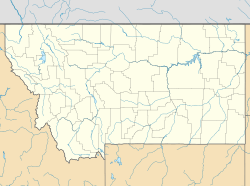Bozeman National Fish Hatchery facts for kids
Quick facts for kids |
|
|
Bozeman National Fish Hatchery
|
|

Aerial view of the Bozeman Fish Technology Center
|
|
| Location | 4050 Bridger Canyon Rd., Bozeman, Montana |
|---|---|
| Area | 0.5 acres (0.20 ha) |
| Built | 1896 |
| Architectural style | Queen Anne, Shingle Style |
| Website | http://www.fws.gov/bozemanfishtech/ Bozemand Fish Technology Center |
| NRHP reference No. | 83001063 |
| Added to NRHP | January 6, 1983 |
The Bozeman Fish Technology Center is an important place for fish research. It's located about 4 miles (6.4 km) northeast of Bozeman, Montana. You can find it near the entrance to Bridger Canyon.
There's also a National Fish Health Center in Bozeman. It's about 7 miles (11 km) away, close to Montana State University. Both centers are part of the National Fish Hatchery System. This system is run by the United States Fish and Wildlife Service.
These centers work with many groups to help protect water animals. There are seven Fish Technology Centers and nine Fish Health Centers in the United States. The Bozeman center is very old, being the fourth oldest National Fish Hatchery. It was added to the National Register of Historic Places on January 6, 1983.
Contents
Discover the Bozeman Fish Technology Center
The Bozeman Fish Technology Center helps keep our water environments healthy. It also works to protect fish species. This center is a key part of the National Fish Hatchery System. It plays a big role in fish research and conservation.
A Look Back: How It Started
The Bozeman National Fish Hatchery was approved by the United States Congress on August 5, 1892. Land for the hatchery was bought on May 20, 1893. It was a 50.3 acres (20.4 ha) area at the entrance to Bridger Canyon.
Building the facilities began in April 1895. Everything was finished by late 1896. Dr. James A. Henshall was the first superintendent. He started working there on January 11, 1897.
The hatchery first focused on raising brook trout and rainbow trout. The center grew, and more land was bought in 1905. In 1966, it changed its focus. It became a Fish Cultural Development Center. Its goal was to improve how Salmonidae fish were raised.
The focus changed again in 1983. It became a Fish Technology Center. This meant it would study a wider range of fish species. Today, it's more of a research and education center than a place that raises fish.
Helping Fish Thrive: Important Work
One big success for the center involved the greenback cutthroat trout. This fish was once thought to be extinct. The center helped change its status under the Endangered Species Act to "threatened." This means the fish is still in danger but is not gone forever.
In August 2004, a new building opened. It was a 16,500 square feet (1,530 m2) laboratory and office space. This building is called the Robert G. Piper Building. It was named after a past director of the center.
What They Study
The Bozeman Fish Technology Center studies many things. They look at how to raise water animals. They also study what fish eat to stay healthy. The center checks on fish populations. They also research fish health.
Their work helps fish in many states. These include Montana, North Dakota, South Dakota, Wyoming, Nebraska, Utah, Colorado, and Kansas.




